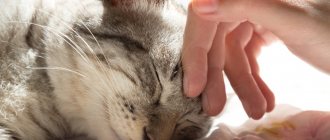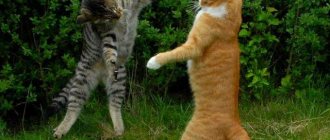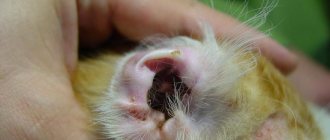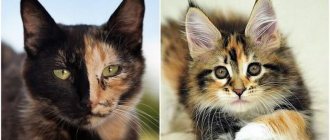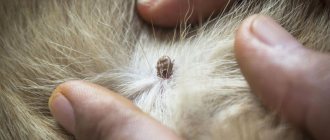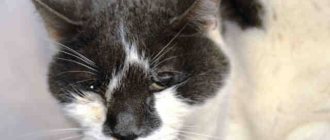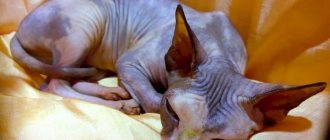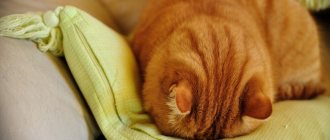How to treat microsporia in cats?
A fungal infection, commonly known as ringworm, can spread on pet fur. The pathology affects the skin, fur and claws of the animal. Several types of fungi lead to infection. The most common are Microsporum Canis and Trichophyton. The diagnosis can also be different - microsporia or trichophytosis in cats. However, the treatment will be the same in both cases. The concept of “ringworm” is a general one and is not used in official documentation.
Development of the disease
Microsporia in cats affects the body of the hair, causing it to become brittle. As a result, the wool breaks off at one level and the effect of cut grass is obtained. As a result of this, the disease got its name.
In cats under one year of age, this pathology is very common. This fact is explained by the immaturity of immunity, the survivability of spores and extreme contagiousness.
Microsporia in cats is most often manifested by the formation of alopecia. As a result, round bald patches appear on the surface of the body, where the skin is covered with scales. The problem is that the infected areas are very itchy and cause severe discomfort to the cat, so the animal constantly scratches them, which contributes to the addition of a secondary infection.
Danger of infection
Microsporia in cats can lead to infection in humans. Young children and elderly people are at greater risk. Therefore, if you suspect lichen, you should protect the animal from strangers, and the person caring for the cat must take all precautions.
When handling your pet, you must wear protective gloves. All animal habitats must be disinfected. If there are other animals in the house, veterinarians recommend vaccinating them. However, not all experts consider the injection to be effective, but still the benefits of vaccination are greater than the harm.
Isosporosis in cats: the pathogen and its danger
Isospora disease in cats is caused by two protozoan parasites: Isospora rivolta and I.felis . These organisms are simple and single-celled and live in the intestines of cats and other domestic animals. Moreover, there are frequent cases of infection in humans
, but human parasites include more specific subspecies of the pathogen.
If we talk about age, then
younger individuals aged from six months to a year are susceptible The disease also often occurs in older pets and already weak animals.
Symptoms of the disease
Microsporia manifests itself quite specifically in cats. Symptoms can manifest themselves in different ways, depending on the degree of damage, the state of the animal’s immunity and its age.
The classic manifestation of lichen is a small, round-shaped spot. At the site of the lesion, hair breaks off and the skin peels off. Small pustules can be found around the perimeter.
It is worth understanding that the disease manifests itself in the form of a small spot and constant itching. But as the disease progresses, the symptoms worsen. More and more affected areas appear, gradually they can merge into a single whole.
Microsporia in cats most often develops in the area of the head, ears and tail. However, signs of infection may appear in other places.
If the spores strongly attack the cat’s weakened body, a generalized form of the disease may develop. Visually, it looks like a constant molting of an animal. Moreover, the skin will no longer be able to recover. Next, ulcers with areas of hemorrhage are formed.
Treatment options
Microsporia in cats causes great discomfort. Treatment involves the use of antifungal ointments, shampoos and taking pills to strengthen the immune system. However, it is worth considering that the spores that cause ringworm are very resistant to drug treatment. Therefore, it is important to complete the prescribed course and prevent relapse.
The cat owner must definitely contact a veterinary clinic for an accurate diagnosis. Only after examinations can medications be recommended, which are divided into groups:
- Preparations for external use. Available in the form of ointments, creams or sprays. To make them more effective, you must first shave the animal. It is also worth considering that antifungal ointments are toxic, and to prevent licking it is necessary to put a special collar on the cat.
- Pills. They may be prescribed when the affected area is large, or if external medications do not cope with the problem.
- Immunomodulators. Treatment of ringworm necessarily involves taking immunostimulating agents and a vitamin-mineral complex.
In complicated cases, antibiotics may be required.
Isosporosis in cats: diagnosis and treatment
Of course, only an experienced veterinarian can prescribe treatment for such a disease.
, already facing symptoms and consequences. He prescribes a comprehensive course to restore the pet. Of course, this includes etiotropic therapy (when the cause of the disease itself is treated, for example, with the help of antibiotics and antibacterial agents) and symptomatic treatment. This includes the treatment of organs and those body systems that have been damaged. Also, due to dehydration, bed rest and IV drips are often prescribed. If the vomiting is particularly severe, then these are antiemetics. If blood appears during bowel movements, it means there is bleeding in the gastrointestinal tract and blood-stopping agents must be used. If diarrhea is particularly severe, then special means are used that bind feces inside the animal and restore this function. And so on, as you can see, there are many ways and they vary, of course, depending on the individual characteristics of the organism.
Separately, it is worth highlighting the dehydration of a sick pet, which is done by a veterinarian using intravenous injections of various minerals, vitamins and products that remove all harmful toxins from the body and restore the animal’s water balance. Ringer's solutions, glucose, and other drugs are administered intravenously to relieve intoxication and eliminate signs of dehydration in the animal.
If you suspect isosporosis in cats, you should also check:
- In addition to these medications, animals are also prescribed the following, but this, again, depends on the individual characteristics of the animal:
- Of course, antibiotics that relieve inflammation in the gastrointestinal tract. They are taken for no more than two weeks, depending on the stage of the disease.
- Diets to restore the intestines and their work.
- Intravenous drips to restore water balance and nourish the animal if it is constantly vomiting.
- Antispasmodics to relieve your pet of intestinal pain.
If diseases are detected in time, then there is no need to talk about death, because the animal quickly recovers with proper care and treatment, even if it is a kitten, a sick or old animal. However, it happens that even with seemingly correct steps, there is no improvement, or it is not so significant. Then the veterinarian should check the following:
- Does the pet have a disease that occurs in parallel or were the symptoms confused and the diagnosis was made. The following is checked:
- Panleukopenia.
- Coronavirus enteritis.
- Giardiasis.
- Worms.
- Toxoplasmosis.
- Intolerance in the intestines.
- Cryptosporidiosis or infection with other bacteria.
Use of antifungal ointments
The very unpleasant appearance of the animal is confirmed by photographs of microsporia in cats. Treatment involves the use of antifungal ointments. They give a noticeable effect, but it is necessary to use them according to the exact scheme proposed by a specialist. The most prescribed ointments are the following:
- "Clotrimazole". Has a pronounced antifungal effect. It is necessary to treat the affected areas three times a day. The course of treatment is two weeks.
- "Mikozon." Completely destroys pathological spores and affects secondary microflora. Treatment involves long-term use. The ointment must be applied twice a day. The course is calculated by the veterinarian based on the degree of exposure.
- "YAM." Ointment with an antiseptic effect. Thanks to its astringent consistency, it softens crusts and significantly reduces itching. The drug only needs to be applied for a week. After a course of treatment, healthy hair begins to grow at the site of the lesion.
Veterinarians often recommend preparing the skin before applying ointments. For this, special solutions are used.
Diagnosis of infection
To eliminate any doubts about the correct diagnosis and prescribe the correct treatment regimen for microsporia in kittens and cats, the veterinarian usually conducts a series of studies. What's included:
- Inspection of the animal - a coating of fungal spores should be visible on bald areas. A Wood's lamp will help identify them. The area affected by microspores acquires a greenish tint in the rays of this device.
- Conducting microscopy - a sample of fur and crusts is taken and examined for the presence of conidia or fungal hyphae.
- Microbiological studies - the samples taken are placed in a special nutrient medium to isolate a pure culture of the pathogen. This will allow you to make the most accurate diagnosis.
Important: before visiting a veterinary clinic, the animal owner should not treat the affected areas with anything. Otherwise, it will make diagnosis very difficult.
Antimycotic agents
To prevent the development of inflammation, it is recommended to use special solutions to prepare the skin for the application of antifungal ointments. The most popular and effective include:
- "Fungin." It is necessary to apply to scratched and inflamed areas twice a day. The course of treatment is two weeks.
- "Exoderil". The active substance is naphthyzine. It is necessary to apply spores to the affected area, covering about 1 cm of the healthy area. They are used only once a day, but the course of treatment should last a month.
- "Imaverol". Antimycotic solution supplied in the form of an emulsion. To use, you must prepare a new portion each time. Before use, the animal must be bathed using antifungal shampoo. Next, every four days the cat’s fur is treated by spraying.
- "Thermikon". The drug is available in the form of a spray. The affected areas must be dried before treatment. The spray must be used twice a day. The course lasts from one to two weeks.
It must be remembered that sprays are highly toxic. Therefore, their use is prohibited in pregnant and lactating animals. However, Imaverol has no such contraindications.
Isosporosis of dogs and cats
Isosporosis of dogs and cats is a parasitic disease caused by several species of protozoa of the genus Isospora. The disease in dogs and cats is accompanied by diarrhea, polyuria, dehydration, exhaustion and intoxication of the animal's body. With a severe degree of infection, the death of animals occurs. In dogs, the causative agents of infection are Isospora bigemina and I. Canis, in cats – Isospora bigemina, I. Felis, I. Rivolta.
Development cycle . Dogs and cats with isosporosis are the final (definitive) hosts. The initial stage of reproduction in them takes place in the small intestine. As a result, oocysts are formed, which are released into the external environment with feces, where sporogony occurs. In this case, two sporocysts are formed in the oocyst and each of them contains four sporozoites. When a mature oocyst enters the body of an intermediate host (many animal species), sporozoites emerge from it and invade the internal organs of the animal, where they transform into trophozoites - Toxoplasma gondii. Gametogony and schizogony occur in the small intestine of dogs and cats. Along with the intestinal stage of parasitism, isospores can also be endogenous, when they penetrate the internal organs - liver, spleen, lungs, lymph nodes, brain.
Epizootological data . The disease is widespread. The disease affects many species of animals and birds of various age groups. In puppies and kittens the disease is more severe than in adult cats and dogs. Carnivores become infected with isospores mainly by consuming food and water infested with oocysts. Newborn puppies become infected from their mother by licking their nipples and the hair around them. Infection is possible through intermediate hosts - mice, rats, waterfowl. Unsanitary conditions, poor living conditions, the presence of helminthic infestations, and poor feeding of animals contribute to infection.
Oocysts can survive in the external environment for up to two years. They are very resistant to chemicals. It is believed that domestic animals are natural carriers and reservoirs of the pathogen. More often, stray and hunting dogs become ill with isosporosis.
Pathogenesis. The development of the disease depends on the species, breed, age and especially the dose of infection. The development of the sexual stages of pathogens usually causes hemorrhagic inflammation of the small intestine, and less often the large intestine. They multiply in epithelial (enterocytes) and subepithelial cells of the intestinal villi. Towards the end of the development of the pathogen, desquamation of the epithelium occurs, which leads to impaired digestion, especially membrane digestion, starvation and intoxication of the body. Absorption of products of inflammation and metabolism of isospores, poorly digested food and toxins of putrefactive microflora leads to depression of the nervous system, damage to the liver, kidneys and general intoxication.
Immunity in cats and dogs with isosporosis lasts 2-6 months, after which they can become infected again.
Symptoms and course of the disease . In dogs and cats, the clinical manifestation of the disease occurs 5-7 days after infection. The disease is accompanied by frequent bowel movements with the release of liquid stool with large amounts of mucus and blood. Stool is often red or orange in color. When examining the visible mucous membranes, their pallor is noted; they are often jaundiced. Appetite is very variable, but often reduced. In severe cases of isosporosis, dogs and cats completely refuse to eat food. The general condition is depressed. Animals are inactive and prefer to lie down more. Polyuria increases. In this case, the urine becomes dark with a sharp putrid odor. Exhaustion and emaciation develop. The abdominal wall is tense and painful upon palpation. The skin loses its elasticity. The coat loses its shine and becomes disheveled. With improper treatment and a poor feeding ration, the disease becomes more severe and ends in the death of the animal. Body temperature, as a rule, rises 0.5-2 degrees above normal.
The chronic course of isosporosis is characterized by: periodic vomiting (vomiting in a dog); dysbiosis (dysbacteriosis in cats, dysbiosis in dogs); periodic diarrhea alternating with constipation (constipation in a cat, constipation in a dog); depressed state; liver dysfunction (liver disease in dogs, liver disease in cats).
With a weak degree of infection, clinical signs of the disease are not typical or may be absent. Diarrhea is periodically recorded (diarrhea in dogs, diarrhea in cats), animals are stunted in growth, and rickets often develop in young animals (Hypovitaminosis D in dogs (rickets).
Pathological data . When autopsying the corpses of dead animals, changes are found mainly in the small intestine. The intestinal mucosa shows signs of catarrhal or hemorrhagic inflammation, with multiple pinpoint and streak hemorrhages. The serous membrane has a bluish-red tint.
Diagnosis . The diagnosis of isosporosis is made comprehensively, taking into account the medical history and characteristic clinical signs. Intravital diagnosis is confirmed by the detection of oocysts in fecal matter using the Fulleborn or Darling method. Posthumously - based on the results of an autopsy and laboratory examination of scrapings from the mucous membrane of the small intestine for the detection of oocysts. In laboratory conditions, their genus and species are determined, for which feces or scrapings are moistened with a 2% solution of potassium dichromate and kept in a thermostat at a temperature of 25-30 degrees for 2-5 days for sporulation of oocysts.
Differential diagnosis . When carrying out differential diagnosis, isosporosis is distinguished from parvoviral enteritis of dogs, panleukopenia of cats, pasteurellosis by bacteriological and virological studies to detect the pathogen. Based on the collected medical history and clinical signs, it is necessary to distinguish from food and drug poisoning.
Treatment . Treatment of the disease should be comprehensive and begin with diet therapy. Sick dogs and cats are first given a fasting diet and then a bland diet. Diet therapy is described in more detail in the article - gastroenteritis in dogs. Feed should be easily digestible, have mucous properties and not irritate the intestinal mucosa.
Chemical coccides are considered to be the best therapeutic drugs. It is prescribed to sick dogs and cats for 3 days. Administered orally with food at the rate of 0.024 g per 1 kg of body weight.
In the absence of this drug, sulfonamide drugs can be prescribed: norsulfazole with food or norsulfazole sodium with water at a dose of 0.03-0.04 g per 1 kg of animal weight, sulfadimezin (in combination with chloridine) or separately at the rate of 0.1-0.4 g for cats per 1 kg of body weight every 6-8 hours, etc. Sulfonamides are usually used for 7 days and under the supervision of a veterinarian. Their effect can be enhanced by the simultaneous administration of antibiotics: chloramphenicol, tetracycline, baytril, bicillin, etc.
Furozolidone has a good therapeutic effect for isosporosis, especially in combination with sulfadimesin or chloramphenicol. It is given to dogs and cats orally at the rate of 10 mg per 1 kg of body weight 3-4 times a day for a week. In parallel with antiparasitic drugs, vitamins B, C and Vicasol are prescribed in therapeutic doses and antiallergic substances - tavegil, suprastin, diphenhydramine, kestin, claridine, etc. under the supervision of a veterinarian.
Symptomatic treatment includes injection of physiological solutions of glucose, Ringer, sodium chloride, etc. subcutaneously and intravenously to reduce intoxication and dehydration of the sick animal. The dose and course of treatment should be determined by the attending physician. A disinfectant enema has good healing properties. A weak pink solution of potassium permanganate or a 0.01% warm solution of furozolidone is injected into the rectum of a sick animal 3-4 times a day. Instead of furozolidone, you can use furacillin in the same concentration. If necessary, heart medications, painkillers and hepatoprotectors are prescribed in therapeutic doses.
Prevention . Animal owners must observe zoohygienic conditions for keeping dogs and cats. Regularly change their bedding, thoroughly wash and disinfect their feeders and drinkers. It is better to dispose of animal feces by burning because... protozoa are able to survive in any conditions. Due to the fact that rats and mice are carriers of isospores, it is necessary to regularly carry out deratization. It is better to boil food, especially meat. The diet should be varied and nutritious.
Reasons for taking pills
How to treat microsporia in cats should be recommended by a veterinarian. If the solutions and ointments described above do not help or the affected area is large, the doctor prescribes special tablets. All oral antifungal pills have a number of side effects. Therefore, they are contraindicated for pregnant and lactating cats. The most popular tablets are:
- "Griseofulvin". The product has a cumulative effect. It has a good effect, but use should last for a month. The usual dose for an adult cat is a quarter of a tablet.
- "Irunin" and "Ketaconazole". Powerful antifungal drugs. They have pronounced antimycotic properties.
- "Flucanazole". A potent drug. It can only be prescribed by a doctor because it has severe side effects. Recommended for large spread of bacteria and secondary infection.
Vaccination
Microsporia is quite common in cats. The photo shows how unpleasant the disease looks. Your doctor may recommend vaccination as treatment and prevention. Despite the fact that not all experts consider this technique to be effective, the injection can still protect the pet from the rapid proliferation of the fungus.
The most well-known antifungal vaccines are Polivak. The instructions state that the drugs not only have a preventive effect, but also have an effective therapeutic effect.
However, any veterinarian will not give a 100% guarantee that the vaccine will protect your pet from infection. It is also a known fact that this method is not used in European countries.
Risk group
Controversies surround us everywhere. They are in the air, on the grass and in the water. Even an animal that is constantly in the apartment is exposed to an opportunistic strain of fungus. Certain types of fungus can remain on a TV pet for many years and only then intensify their harmful effects. Others cause irritation immediately, thereby instantly undermining the cat’s health. There are even some that pose a danger to humans.
Fungus of the genus Microsporum under a microscope
Homeless animals are considered the main carriers of the disease. Fungal spores are released from affected hairs and scales. Microsporia can be transmitted through contact between an infected cat and a healthy one, through hygiene and household items where the villi of the fungal strain have already settled.
At risk are:
- severely emaciated and weakened;
- with low immunity;
- poorly cared for by the owner;
- those who are poorly fed or whose diet is unbalanced;
- constantly in contact with stray cats who may be diagnosed with microsporia.
A healthy and strong animal has less chance of contracting the disease.
Pathogenesis
Parasites violate the integrity of the mucous membrane. Putrefactive microflora joins. Bacterial metabolites are poisonous. Intoxication occurs, dehydration occurs, and the functioning of the heart, liver, and kidneys is disrupted. Recovered animals turn into carriers of infection. Immunity develops to varieties of cystoisospores that participated in the invasive process. Therefore, recovered kittens become infected again. Puppies acquire intense immunity. Among the factors contributing to the development of the disease are stress, dirt, poor nutrition or a sudden change from one food to another.
Symptoms of the disease
The signs of microsporia are as follows:
- the appearance of a small rash, which is extremely difficult to notice in a pet with long and thick fur;
- the pet feels restless and often itches in the same place;
- as a result of active scratching, fur may appear on the body, broken off in some places;
- in places where fur has fallen out or broken off, the skin swells and becomes blue.
If the form is erased and hidden, the spot may remain unchanged for years.
When the disease becomes more profound, the symptoms intensify:
- in areas of hair loss, the skin actively peels off;
- lesions spread, forming large voids on the pet’s body;
- as a result of severe itching, wounds and irritations appear. They may bleed and crust;
- foci of the disease appear on the paws, face and tail of the cat.
Diagnosis of microsporia
Diagnosing ringworm on your own is extremely difficult. Because it is necessary to conduct a number of laboratory and instrumental studies. The disease can be confused with trichophytosis, scabies and favus.
- a coating of fungal spores is visible on the lesions;
- In the veterinary clinic, the veterinarian has a special black lamp called Vuda. If you shine light on an animal's fur, the affected areas will have a green tint;
- taking scrapings from the pet’s skin and smears.
Treatment of cats
The standard course of treatment for microsporia takes at least 6 weeks. We can talk about complete recovery only after laboratory tests. External examination does not mean anything.
The following pharmaceutical products are used to treat the skin of a pet and its wounds:
- Ointments: micoseptin and miconazole.
- Spey: zoomicol and kubatol.
- If desired, you can purchase specialized shampoos or creams.
For internal use, it is recommended to buy tablets, for example, fulvicin, fungivin or grifulin. They are taken for one month. The dosage depends directly on weight at the rate of 25 mg of the drug per 1 kg of live weight.
Mikoseptin is one of the most effective antifungal agents to help your pet
Since antifungal drugs have a very aggressive effect on the liver, it is recommended to additionally take drugs to support it, including vitamin and immune-stimulating complexes.
Microsporia can be cured if you follow all the veterinarian’s recommendations and do not interrupt the course of treatment.
Treatment of ringworm
Under no circumstances should you try to cure an animal without the assistance of a doctor. This is fraught with infection of the owner and all family members, as well as animals living together. In addition, when buying the first anti-fungal ointment you come across, you should not expect positive results. After all, at home it is impossible to determine the exact type of fungus, which means treatment will be useless. In addition, many fungal remedies intended for humans are toxic to animals. After the disease is diagnosed, the doctor will prescribe a course of treatment, which includes: shampoos, sprays, ointments, creams, tablets and vaccines. Medicines have a negative effect on the animal’s liver, therefore the following are prescribed without fail:
- Regenerative drugs for the liver;
- Drugs that enhance immunity;
- Vitamin complexes.
Complete recovery requires about 1.5-2 months, the period depends on the severity of the disease and the responsible attitude of the animal owner to treatment.
Important: you cannot interrupt treatment on your own, even if it seems that the disease has subsided. A return visit to the veterinarian is required, who will take tests again. Only after the doctor determines that the cat is healthy can treatment be stopped.
Caring for a sick cat
In order for your pet to recover faster, its owner is advised to carefully monitor cleanliness and hygiene. Constantly disinfect the surfaces of the house where a sick animal is, minimizing the spread of fungal spores in the apartment. You need to follow all the veterinarian's instructions and take care of the cat. Apply ointment to his wounds, take pills and vitamins. Establish a balanced diet. Sometimes you may even need a daily routine. It is important here to help the animal regain its strength and gain energy, since the disease is debilitating.
If you do everything as the vet said, there is no need to worry. At the end of the course of treatment, laboratory tests are carried out again to make sure that the animal has become completely healthy and that ringworm no longer bothers it.
Is microsporia in cats dangerous for people?
There are certain types of fungi that are dangerous to humans. That is why experts do not advise self-medicating your pet if signs of microsporia appear. It is important to diagnose the disease in time and take all measures to treat it as quickly as possible. Older people and young children most often catch the disease. They are the ones at risk.
Some fungi parasitize human skin, so microsporia can be contagious to people
Prevention
To prevent the disease it is recommended:
- Vaccinate your animal regularly;
- minimize the “communication” of your pet with stray animals;
- provide good care for the cat;
- constantly remove and clean your pet’s household items;
- treat animal fur from ticks and fleas;
- establish high-quality and balanced nutrition.
Microsporia is a disease that can be cured within a month if you follow all the recommendations and prescriptions of the veterinarian. There is no point in trying traditional methods here.
This is especially true for young children and the elderly.
Symptoms and treatment of microsporia in cats.
Trichophytosis in cats is an infectious disease in which areas of the skin appear with signs of flaking, hairs broken off at the base or with severe inflammation and a thick crust. Fungi of the genera Trichophyton, Microsporum, Achoreon cause 3 different diseases - trichophytosis, microsporia and scab. Microsporia and trichophytosis manifest themselves similarly, so they are combined under the popularly known name - ringworm.
Microsporia in cats is caused by fungi of the genus Microsporon. This disease is dangerous not only for animals such as cats, dogs, rats, but also for humans. The spores of the disease are all around us: both in the air, on the grass and/or on the ground, and on the skin of animals, people, their clothes, shoes.
The danger of microsporia for humans and other animals
Microsporia is a highly contagious disease for both humans and pets living together with a sick cat, and therefore requires quarantine measures. In humans, lichen causes ring-shaped or round-shaped skin lesions that accompany inflammation, as well as severe skin itching.
Ringworm is a highly contagious (contagious) infection of the skin, hair, or nails.
Symptoms of microsporia in cats
There are 4 forms of the disease:
- hidden, this form can affect strong adult animals, while the symptoms of the disease are poorly distinguishable and require a thorough examination of the animal;
- erased, with small bald patches, signs of the disease are not pronounced;
- superficial, when there may be one or several areas without hair or with broken hairs, inflammation is absent or mild;
- follicular form, with this form a pronounced inflammatory process occurs on the skin, there are crusts and ulcers.
The following symptoms should be assessed to identify the disease:
- rash on the animal's skin;
- severe itching, as a rule, the cat becomes restless and scratches heavily in the same areas;
- the appearance of places on the skin with hair broken off at the base or completely fallen out;
- swollen and/or bluish skin in the area of the bald patch.
Microsporia in a cat can develop into a deeper form. The following symptoms may appear:
- flaky skin in areas of bald spots;
- large lesions;
- the appearance of wounds and crusts on the skin;
- spread of foci of inflammation to the paws, muzzle, in the tail area, on the tail.
Typically, the disease may begin with the appearance of a spot on the cat's skin, and other symptoms may appear later. In this case, the skin is clean, whitish, and may be covered with grayish scales. The fur around this area is easily pulled out. The animal must be treated, otherwise the disease will grow, the foci of the disease increase in size, bald patches can spread throughout the animal, the skin can become inflamed, and pus can accumulate under the crust. The inflamed areas of the skin itch, the cat itches a lot, while spreading the fungus to other areas of the body.
Microsporia in any form significantly impairs the animal’s immunity. With erased and hidden forms, one spot may remain unchanged for a long time. The incubation period of the disease is from several weeks to 2 months.
Helpful information
Fungal spores are unpretentious and tenacious, and they are adapted to the most unfavorable conditions. They are not afraid of temperature changes, humidity or disinfectants. There is always a risk of infection, because spores can remain in the soil for up to 2 months, and therefore be transferred into the house on a person’s clothes or shoes. The worst thing is that some fungi that cause microsporia can remain on the animal’s fur for a long time and not manifest themselves in any way. This is especially true for cats with good immunity. Symptoms will appear only after weakening health or at a time of stress. Another category of fungi instantly affects the skin, so symptoms appear almost immediately.

